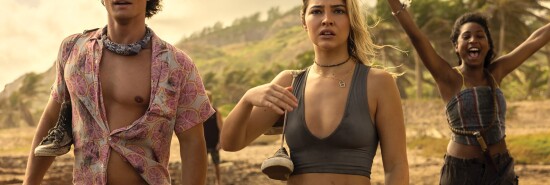
Outer Banks is a pioneer in moodboard TV
Katherine Dee
Critics’ reaction to the third season of Netflix’s Instagram-filtered teenage original Outer Banks has, for the most part, been “Damn, it fell off.” (That’s Zoomer for “It jumped the shark.”) Despite this, it seems like audiences still love it.
The argument against Outer Banks goes something like this: Unlike seasons one and two, which at least offered viewers a fun, if trashy, romp replete with adolescent class warfare, sexy melodrama, and a treasure hunt, season three is difficult to make sense of. The foundation of the show’s conceit crumbles not once but twice, and each new plot point feels like a meandering side quest. The fine people at the Harvard Crimson even dubbed it “the definition of bad storytelling” in a piece that’s as clumsy and unreadable as they think Outer Banks is unwatchable.
Outer Banks is about a group of friends dubbed the “Pogues,” which is the show’s word for “townie.” It’s a grab bag of teenage shenanigans, melodrama with the wealthy out-of-towners they call the “Kooks,” and an expedition that culminates in the group getting stranded on a desert island they nickname “Poguelandia.” The first two seasons were kind of like televised airport literature. It was not masterly craft, but it was not surprising this shlock was such a smash hit (especially given the fact it serendipitously premiered during the height of COVID-19 lockdowns).
Season three begins in Poguelandia, but we’re quickly taken on an action-packed odyssey of car chases and kidnappings through South America. There’s no succinct way to describe what exactly unfolds. There are a lot of scenes — more accurately, a lot of images.
Yes, Outer Banks’s third season is difficult to make sense of if you’re evaluating it as regular television, even exceptionally trashy regular television. Those of us who grew up before the age of TikTok and Instagram reels have certain expectations of TV. At a minimum, we want a three-act structure, some character conflict we can sink our teeth into, at least the bare minimum of acting chops.
But here’s the thing. Outer Banks wasn’t created for people who grew up before commercial internet domination. It was written for people who’ve only known a world of endless scrolling, moodboards, and “likes.” And it makes me wonder if what seems to be a global vanishing of traditional plot structure isn’t the product of bad writing, bad funding, or poor hiring practices but rather a natural and necessary evolution of the medium of television. Hear me out here. There’s a reason people like it. If it were “so unwatchable,” as millennial (and at least one Ivy League Zoomer) critics claim, nobody would be watching it.
If you view Outer Banks from a different vantage — one that sees it as something designed to be screencapped, clipped, and used as the building blocks of a “vibe” — the show remains quite good. This evaluation applies to all three seasons. Outer Banks has a distinct energy, lack of traditionally compelling narrative aside. It’s summery and vaguely reminiscent of Abercrombie. It brings to mind a series of tags: #goldenhour, #sunset, #lastdaysofsummer. One can even imagine what an Outer Banks signature scent might smell like. And you don’t have to imagine what Outer Banks-core (stylized obxcore) would look like, either — adolescents on TikTok, Tumblr, Pinterest, and Instagram already have.
Its third season is designed to represent a mood, not to be binge-watched in a single sitting as you hungrily await what’s going to happen next. Fandom in that way is for us millennials, I suspect. We love stories, even if those stories have been played out. But Zoomers and maybe even Generation Alpha are vibe-hounds in search of new aesthetics to filter over their imaginations. If we millennials wanted to inhabit the characters in our media, Generations Z and A merely want to meander into new worlds. It’s not an inferior art form. It’s one that’s entirely separate; it’s one that might be going through its own adolescence.
As they say: It’s a mood.
Katherine Dee is a writer and co-host of the podcast After the Orgy. Find more of her work at defaultfriend.substack.com or on Twitter @default_friend.
